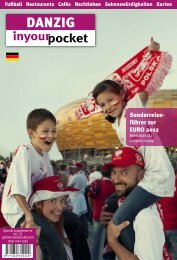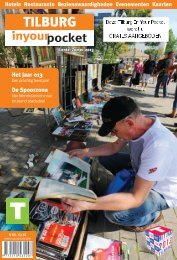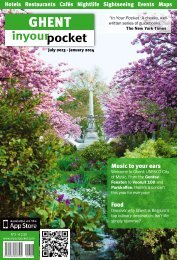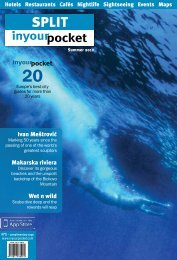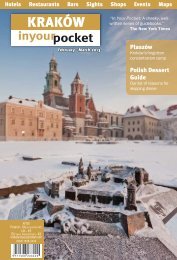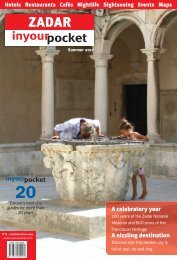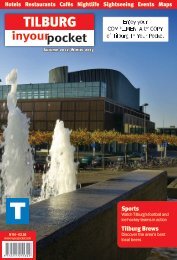7kh 7ul flw\ v prvw dxwkhqwlf 7h[ 0h[ uhvwdxudqw ... - In Your Pocket
7kh 7ul flw\ v prvw dxwkhqwlf 7h[ 0h[ uhvwdxudqw ... - In Your Pocket
7kh 7ul flw\ v prvw dxwkhqwlf 7h[ 0h[ uhvwdxudqw ... - In Your Pocket
You also want an ePaper? Increase the reach of your titles
YUMPU automatically turns print PDFs into web optimized ePapers that Google loves.
70<br />
HEVELIUS<br />
When talking about Gdansk’s most famous resident, you<br />
not only have to decide which name to use - - Johannes<br />
Hevelius if you’re German or Jan Heweliusz in Polish - but<br />
how exactly to credit him first. As a popular brewer? A successful<br />
astronomer? A prolific inventor? The onetime mayor<br />
of Gdansk? The Da Vinci of Poland?<br />
With a resume like that it makes sense that Gdansk devoted<br />
2011 - the 400th anniversary of Hevelius’s birth - to honouring<br />
what one local publication called “The man of the millennium.”<br />
Normally recognised with a week each year, Hevelius<br />
was upgraded to a full year’s worth of activities, events and<br />
celebrations to honour all his achievements.<br />
A life in Gdansk<br />
Born in Gdansk in 1611 into a wealthy German-speaking<br />
family, Hevelius was one of three brothers and six sisters<br />
and the only male child to make it to adulthood. The German-<br />
Czech children of Abraham Howelcke and Kordula<br />
Hecker had a privileged upbringing, and Hevelius was sent to<br />
Gymnasium at the age of seven. There Hevelius was taught<br />
by Peter Cruger, who encouraged the boy’s early fascination<br />
with mathematics and astronomy.<br />
Though Hevelius chose to pursue law at Leiden University in<br />
Holland, his interest in astronomy was always at the forefront<br />
of his mind. After leaving school Hevelius travelled around<br />
Europe seeking out leading astronomers like Pierre Gassendi<br />
and Ismael Boulliau before his parents called him home - just<br />
short of his final destination, Galileo in Italy.<br />
The summons to Gdansk meant Abraham and Kordula were<br />
ready for Hevelius to stop chasing astronomers and instead<br />
take over the family brewery. Hevelius did just that, marrying<br />
neighbour Katherine Rebeschke in 1635 and embracing the<br />
family tradition of brewing beer. Yet despite his devotion to<br />
beer (Hevelius helmed the local brewing guild), the pull of<br />
astronomy was one he could not ignore.<br />
Astronomical achievements<br />
The combination of an eclipse of the sun in 1639 and the<br />
pleas of his former teacher, Peter Cruger, to resume his interest<br />
in the stars inspired Hevelius to take up his former hobby<br />
once again. <strong>In</strong> 1641 he constructed an observatory on the<br />
roof of his home where he worked on creating instruments<br />
for the study of astronomy that quickly outpaced anything<br />
seen in Europe - including a 150-foot telescope built on the<br />
shore of the Baltic Sea. Hand-grinding his own lenses and<br />
creating his own sextants was part of the everyday task of<br />
stargazing at the Hevelius home.<br />
With these homemade tools Hevelius quickly became a<br />
master of his science, discovering numerous constellations<br />
and comets, extensively documenting the topography of the<br />
moon, and observing the phases of mercury and spots on<br />
the sun. These discoveries and observations led Hevelius to<br />
publish 20 works in Latin detailing his findings, many using<br />
his own well-crafted illustrations.<br />
Unsurprisingly, Hevelius’s work and stunning observatory<br />
caught the attention of his peers, and he was elected to<br />
the Royal Society of London in 1664 (the first Pole in the<br />
Society’s history). He also received a visit from Edmund<br />
Halley, discoverer of Halley’s Comet, who sought to compare<br />
Hevelius’s use of a sextant with open sights to the use of a<br />
sextant with telescopic sights. The winner? Hevelius proved<br />
he could assess star positions without a telescope as easily<br />
(and accurately) as Halley could with.<br />
Throughout his work in astronomy Hevelius was also heavily<br />
involved in municipal matters in Gdansk. <strong>In</strong> 1640 he became<br />
the church administrator at St.Catherine’s Church, and<br />
served for a decade as a court juror. And from 1651 until<br />
his death, Hevelius was a councillor for the city of Gdansk.<br />
Despite his many roles in the town and running a successful<br />
brewery, paying for his research required Hevelius to seek<br />
the patronage of Polish kings and queens in order to gain<br />
financial support. King Jan Kazimierz and Queen Maria<br />
Ludwika were the first royalty to visit the observatory, and<br />
King Jan III Sobieski the first to give Hevelius a permanent<br />
annual salary for his work - - which might explain why Hevelius<br />
named a constellation “Scutum Sobiescianum” (Sobieski’s<br />
shield). Hevelius also drew an annual salary from the French<br />
King Louis XIV.<br />
Money wasn’t the only hurdle for Hevelius. <strong>In</strong> 1662 he lost<br />
his longtime wife Katherine, who for many years had run<br />
the family brewing business so her husband could focus on<br />
astronomy. A year later the 52-year-old Hevelius married<br />
16-year-old Elizabeth Koopman, who quickly became a<br />
partner and ally in Hevelius’ work (many consider Koopman<br />
to be the first female astronomer and “the mother of moon<br />
charts”). <strong>In</strong> between giving birth to four children she managed<br />
the observatory and, following his death, completed their<br />
jointly created catalogue of 1,564 stars called Prodromus<br />
astronomiae. She is memorialised in astronomy by lending<br />
her name to a minor planet and, excitingly, a crater on Venus.<br />
Tragedy struck the family again when a fire ravaged the<br />
observatory in 1679; all of Hevelius’s instruments and tools<br />
were destroyed in the blaze. Though he quickly repaired<br />
the space in time to observe the great comet of 1680 (and<br />
named the constellation Sextans in honour of his destroyed<br />
instruments) his health was permanently damaged by the<br />
shock of the disaster and Hevelius died on his 76th birthday<br />
in 1687.<br />
Today Hevelius’s legacy can be seen throughout Poland and<br />
the world. Fellow astronomers have named a moon crater<br />
and an asteroid after the scientist, and his designation of<br />
IH Cassiopeiae is still in frequent use today. Both the Polish<br />
Navy and Polish Oceanliners have named ships in his honour<br />
Gdańsk <strong>In</strong> <strong>Your</strong> <strong>Pocket</strong> gdansk.inyourpocket.com<br />
What to see<br />
Despite the passing of over 300 years since his death and<br />
the destruction of WWII, it is still possible to find traces of<br />
Hevelius in the city, whether they be places where he lived,<br />
worked and now rests or monuments to the man.<br />
For more information on events related to the Hevelius 2011<br />
celebration, visit www.janheweliusz.pl (though so far the site<br />
is only in Polish).<br />
ul. Piwna (Piwna street) B/C-4. You can also wander<br />
along streets that were important in the life of Hevelius.<br />
Beers fans will enjoy a walk down Gdansk’s ulica Piwna, which<br />
was once named Jopengasse after the popular Heveliusmade<br />
Jopenbier brand. For many years it was possible to<br />
buy Heweliusz beer as well (one of <strong>In</strong> <strong>Your</strong> <strong>Pocket</strong>’s favourite<br />
Polish beers) which was brewed locally, but that unfortunately<br />
fell victim to the streamlining of the Polish brewing industry by<br />
the big multi-nationals a few years back. <strong>In</strong>stead keep an eye<br />
out for the Johannes brew which has been specially created<br />
by the local Amber Brewery to commemorate Hevelius Year.<br />
Hevelius’s Home & Brewery (Kamienice Heweliusza)<br />
B-2, ul. Korzenna 2/4/6 (corner of ul. Heweliusza).<br />
Following Hevelius’s marriage in 1635 to his neighbour<br />
Katherine Rebeschke, he took over a pair of tenement<br />
houses and a brewery which came to him as part of his newwife’s<br />
dowry. This property expanded in 1649 when Hevelius<br />
inherited his family’s adjacent house and brewery following<br />
his father’s death, the new property covering an area which<br />
filled most of the space between (B-2/3) Korzenna, Bednarska<br />
and Zawrotna. The property would have consisted of the<br />
living quarters at the front, brewery to the rear and ultimately<br />
Hevelius’ observatory on the roof. The Hevelius family was<br />
to live and work here for many decades and the property is<br />
thought to have remained in the family until the start of the<br />
19th century. Photographs taken over a hundred years later<br />
suggest parts of the structure from Hevelius’ time still existed<br />
but these, like much of the surrounding city were destroyed in<br />
the fall of Danzig in 1945. Despite attempts to re-create the<br />
tenements in the 1950s, the ruins were finally pulled down<br />
and a new residential block built on the site, a building which<br />
today awaits renovation. While many sources quote the address<br />
of the Hevelius home and brewery as 53-55 Korzenna<br />
today you will find them allocated different numbers on the<br />
same street. A unkempt plaque denotes the spot where the<br />
great man once worked and lived.<br />
gdansk.inyourpocket.com<br />
HEVELIUS<br />
Johannes Hevelius<br />
Monument (Pomnik<br />
Jana Heweliusza) B-3,<br />
ul. Korzenna. This statue<br />
was designed by Jan Szczypka<br />
and unveiled on January 28th<br />
2006, the 395th anniversary<br />
of his birth in the gardens dedicated<br />
to him opposite the Old<br />
Town Hall. Hevelius is widely<br />
regarded as the last great<br />
astronomer to work without<br />
lenses and instead made<br />
many of his discoveries using<br />
a quadrant and alidade, tools he is depicted with here as he<br />
stares up at a wonderful recreation of his work on an adjacent<br />
surviving pre-war building.<br />
Old Town Hall (Ratusz Starego Miasta) B-3,<br />
ul. Korzenna 33/35, tel. (+48) 58 301 10 51, www.<br />
nck.org.pl. This marvellous 16th-century Renaissance<br />
building was once home to the office of Hevelius in his role<br />
as an Old Town Council Lord. The former headquarters of<br />
the Council of Gdansk, the Old Town Hall served as the<br />
headquarters of the Soviet Army during the dying days of<br />
WWII, probably because it was practically the only building<br />
left standing in the city at the time. Today the building<br />
is open to the public and has become the focus of much<br />
creativity. Concerts are held upstairs, and the superb<br />
Baltic Sea Cultural Centre (see Culture & Events) now<br />
have their offices there. There’s also a cellar restaurant,<br />
and a good bookshop on the ground floor. QOpen 10:00<br />
- 18:00. Admission free.<br />
St. Catherine’s Church (Kościół Św. Katarzyny)<br />
C-3, ul. Profesorska 3, tel. (+48) 58 301 15 95. This<br />
14th century brick church, the former parish church of the Old<br />
Town and where Hevelius was once church administrator, is<br />
also his final resting place. You will find his tomb at the rear<br />
behind the altar along with an epitaph funded by his grandson<br />
nearly 100 years after the great man’s death. Following a<br />
fire in 2006, which resulted in the ceiling collapsing, work to<br />
restore the church took a number of years. A fairly spartan<br />
scene, the highlight is a 76 metre baroque tower housing a<br />
49-bell carillon, which has chimed on the hour - every hour -<br />
since the 50th anniversary of the outbreak of WWII in 1939.<br />
A display about the fire and the history of the church can be<br />
found under the church tower. Q Open 10:00 - 15:00, Sun<br />
08:00 - 13:00. No visiting during mass please.<br />
St. John’s Church (Kościół św. Jana) D-3, ul.<br />
Świętojańska 50, tel. (+48) 58 301 10 51, www.sw-jan.<br />
vn.pl. Near the Motława River between ul. Świętojańska and<br />
ul. Straganiarska you’ll find this huge brick vault dating from<br />
the 1300s and the church in which Hevelius was christened<br />
in 1611. Having had the misfortune to have been built on<br />
swampland, what remains of the edifice is slowly sinking on<br />
one side although work in recent years has tried to shore it<br />
up. Though it was burnt and completely abandoned after<br />
WWII, it’s now the subject of a huge refit that might well see<br />
it return as one of the great landmarks of Gdańsk. While<br />
many of the interior fittings have been moved to St. Mary’s<br />
its famous 12 metre high renaissance altar remains. This<br />
remarkable phantom of a church is now seeing its interior<br />
being restored and work is planned to be completed by the<br />
end of June 2012. Once fully re-open we look forward to<br />
enjoying one of the most haunting venues in the city which<br />
regularly plays hosts to exhibitions and some wonderful<br />
concerts thanks to the building’s unique acoustics. Q Open<br />
10:00-18:00. No visiting during mass please.<br />
May - July 2012<br />
71



